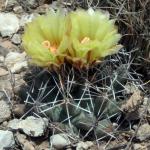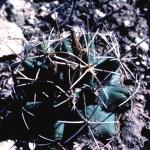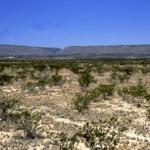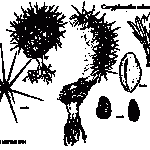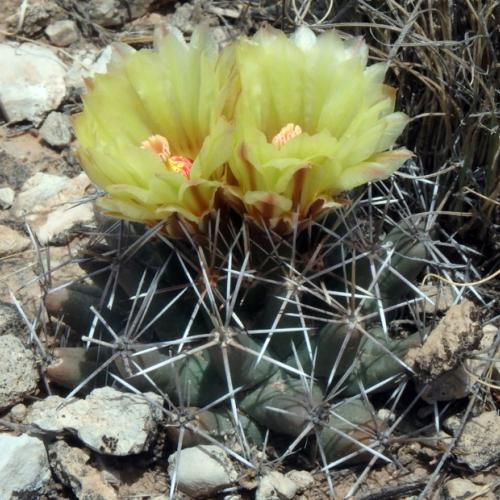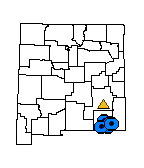Coryphantha robustispina ssp. scheeri (Scheer's Pincushion Cactus)
ECHINOCACTUS MUEHLENPFORDTII POSELGER; MAMMILLARIA ENGELMANNII CORY; CORYPHANTHA NEOSCHEERI BACKEBERG; CORYPHANTHA SCHEERI VAR. SCHEERI (MUEHLENPFORDT) L. BENSON
| USFWS | State of NM | USFS | BLM | Navajo Nation | State Rank | Global Rank | R-E-D Code | NMRPTC Status | Strategy Status |
|---|---|---|---|---|---|---|---|---|---|
| E | SEN | S3 | G4T3 | 1-1-2 | R | SS |
| Overall Conservation Status | Documented Threats | Actions Needed |
|---|---|---|
| WEAKLY CONSERVED | Residential and commercial development |
Status surveys on abundance, and distribution, trend monitoring, assessment of threats |
Stems succulent, hemispheric, tubercled, up to 15 cm in diameter and tall, or exceptionally taller, usually single but sometimes a few in a cluster; tubercles to 7 mm long, conical, somewhat dorsiventrally flattened, with a felted groove running the length of the upper side; spines usually straight, with mostly 6-12 radials to 2.5 cm long, some upper radials often much like the central spine; central spine usually single, stouter than radials, and to 4 cm long (but usually shorter); flowers about 5 cm wide, yellow, rarely streaked or blushed with reddish in center; stamens yellow to orange; fruit to 3 cm long by 1.5 cm wide, green, the pulp juicy and mucilaginous, the perianth deciduous when mature; seeds brown, nearly smooth, about 2-3 mm long, somewhat flattened and kidney-shaped, with a lateral hilum. Flowers May to July, and possibly to as late as November.
In New Mexico, Coryphantha robustispina ssp. uncinata, C. macromeris, and Escobaria vivipara are similar. Coryphantha robustispina ssp. uncinata occurs farther to the west and has usually more than one central spine, more than 11 radial spines, spines stouter, and the flowers, fruits, and seeds average slightly larger. The main central spine is often curved down and occasionally hooked (the basis for the name "uncinata"). Coryphantha macromeris differs in smaller size, clustering habit, groove not reaching the base of the tubercle, lavender to magenta flowers, and smaller, rounder seeds. Escobaria vivipara co-occurs with Coryphantha robustispina ssp. scheeri, and usually has more than one central spine, subcentral spines, and more than 11 radial spines, spines thinner and more colorful, and pale-pink to magenta flowers. Echinocereus fendleri ssp. fendleri is also mistaken for C. robustispina ssp. scheeri; E. fendleri ssp. fendleri stems have ribs rather than tubercles.
New Mexico, Chaves and Eddy counties; adjacent western Texas, Brewster, Crockett, Loving, Pecos, Reeves, Terrell, Ward, and doubtfully Maverick counties.
Sparse throughout calcareous, loamy soils in desert grassland and Chihuahuan desert scrub, usually in slightly-sloping to nearly level gravelly or silty soils on or surrounding limestone or gypsum benches, hills and bajadas; 900-1,100 m (2,900-3,600 ft).
This subspecies occurs primarily the Pecos River drainage in western Texas and southeastern New Mexico; it is unknown if it is present in adjacent Coahuila. The subspecies scheeri shows kinship to Coryphantha sulcata, which occurs farther to the east. The variety scheeri is little studied, and population dynamics are not well understood. Apparently populations exist over wide areas in low densities.
Since populations are apparently comprised of relatively few long-lived individuals, it is likely that any impact may be detrimental to the health of the populations. Plants are commonly observed to be dislocated or damaged by trampling and to be eaten by livestock. Off-road vehicles and commercial and residential development seem to have a limited impact in some areas. Landscape scale herbicide application and oil and gas development may have significant impacts on the species rangewide.
Baker, M.A. and C.A. Butterworth. 2013. Geographic distribution and taxonomic circumscription of populations with Coryphantha section Robustispina (Cactaceae). American Journal of Botany 100(5): 984-997.
*Benson, L. 1970. The Cactaceae. In: C.L. Lundell and collaborators. Flora of Texas 2:221-317. Texas Research Foundation, Renner.
Benson, L. 1982. The cacti of the United States and Canada. Stanford University Press, Stanford, California.
*Weniger, D. 1970. Cacti of the Southwest. University of Texas Press, Austin.
*Schulz, E.D. and R. Runyon. 1930. Texas cacti. Texas Academy of Science, San Antonio.
*Britton, N.L. and J.N. Rose. 1923. The cactaceae, vol. IV. Carnegie Institution, Washington, D.C.
Zimmerman, A., C. Glass, R. Foster and D. Pinkava. 1997. Cactaceae. Pages 205-354, In: J. Henrickson and M.C. Johnston (eds.). A flora of the Chihuahuan Desert region, ed. 1.2, 2 vols. Published by J. Henrickson, Los Angeles (trial version for correction).
For distribution maps and more information, visit Natural Heritage New Mexico


